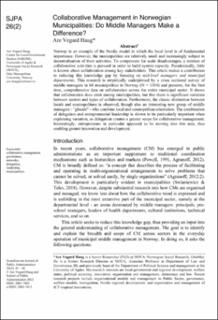Collaborative Management in Norwegian Municipalities: Do Middle Managers Make a Difference?
Academic article
Published version
Permanent lenke
https://hdl.handle.net/11250/3040451Utgivelsesdato
2022Metadata
Vis full innførselSamlinger
Originalversjon
Scandinavian Journal of Public Administration. 2022, 26 (2), 41-66. https://ojs.ub.gu.se/index.php/sjpa/article/view/5099Sammendrag
Norway is an example of the Nordic model in which the local level is of fundamental importance. However, the municipalities are relatively small and increasingly subject to decentralisation of their activities. To compensate for scale disadvantages, a mixture of collaborative activities is pursued in order to build system capacity. Paradoxically, little is known about collaboration among key stakeholders. This article makes a contribution to reducing this knowledge gap by focusing on mid-level managers and municipal departments. This research is empirically underpinned by a cross sectional survey of middle managers in 64 municipalities in Norway (N = 1354) and presents, for the first time, comprehensive data on collaboration across the entire municipal sector. It shows that collaboration does exist among municipalities, but that there is significant variation between sectors and types of collaboration. Furthermore, the classic distinction between locals and cosmopolitans is observed, though also an interesting new group of middle managers - "glocals" - who combine local and cosmopolitan orientation. The combination of delegation and entrepreneurial leadership is shown to be particularly important when explaining variation, as delegation creates a greater scope for collaborative management. Interestingly, entrepreneurs in particular appeared to be moving into this area, thus enabling greater innovation and development.

